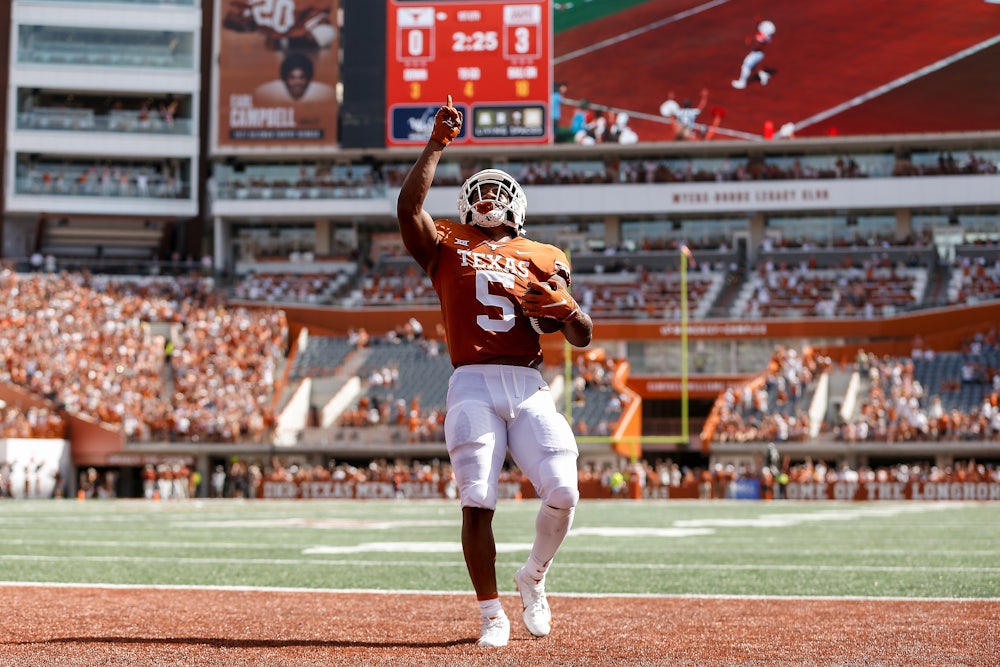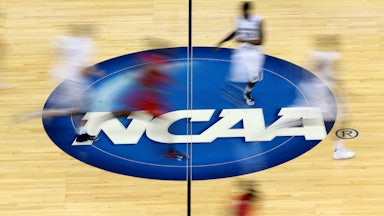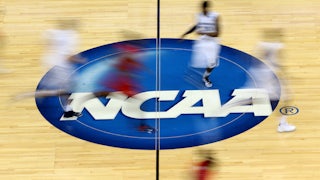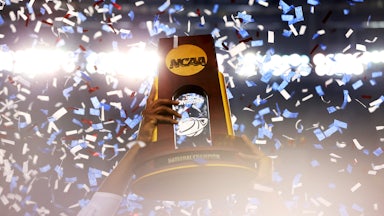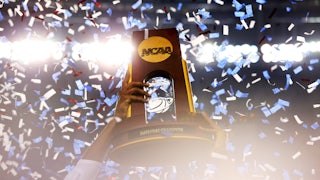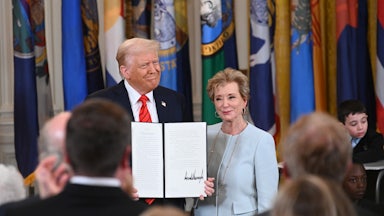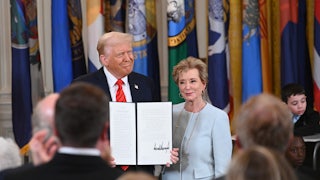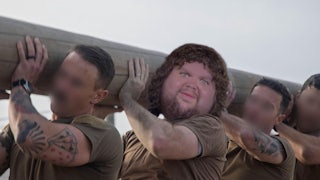The Supreme Court is fairly out of step with American public opinion these days. The conservative justices’ decision to overturn Roe v. Wade last term led to a sizable electoral backlash at the polls against state and federal Republican candidates. Every opinion poll also shows that public esteem for the court has plummeted over the past two years.
In one area, however, the justices were ahead of the curve. In the 2021 case NCAA v. Alston, the court unanimously sided with college student-athletes in an antitrust challenge to the college-sports association’s rules against compensating athletes. The ruling itself was somewhat narrow: It only addressed what the lower courts had described as “education-related compensation,” which included things like tutoring, internships, postgraduate scholarships, and so on.
But the court’s basic application of antitrust laws to the nation’s college-athletics system, as well as its cross-ideological criticism of the status quo where student-athletes generate billions in revenue and receive none of it, was a dismal sign for the NCAA’s hopes at maintaining its hegemony. The American people apparently agree: An August survey by Sportico and the Harris Poll found that 67 percent of Americans support direct compensation for student-athletes. Smaller majorities also favor recognizing student-athletes as employees and allowing them to unionize.
The Alston case began as a lawsuit by then current and former student-athletes under the Sherman Antitrust Act. They sought to overturn the NCAA’s restrictions on the amount and kinds of compensation that schools can provide to student-athletes, specifically targeting the men’s football and basketball programs. The broadcast rights alone for those two sports are worth tens of billions of dollars, which goes to the schools, the conferences, the coaches, and the athletic programs, but not to the students.
The NCAA fought tooth and nail against the lawsuit, arguing that it was effectively exempt from ordinary antitrust laws. “A defining characteristic of NCAA-regulated college sports has been that they are played by amateur student-athletes, i.e., college students who are not paid for their play,” the association said in its brief for the justices in Alston. “As this Court has recognized, amateurism in college sports is procompetitive because it widens choices for consumers by distinguishing college sports from professional sports.”
Three of the nation’s four major professional sports leagues have partial antitrust exemptions under federal law, particularly when it comes to selling broadcast rights. The fourth, Major League Baseball, has a much broader exemption to antitrust laws that is rooted in both federal laws and in Supreme Court rulings dating back to 1922 that gave baseball a privileged (and controversial) status in American commerce. The NCAA does not have a statutory exemption to antitrust laws, but it has long considered a 1984 Supreme Court ruling’s deference to amateurism as giving it wide latitude when drafting anti-competitive rules.
That bubble was punctured in 2014 when a federal judge in California ruled in favor of Ed O’Bannon, a former UCLA basketball player who sued to stop the NCAA from licensing his image and likeness for video games. Judge Claudia Wilkins concluded that amateurism in and of itself was not sufficient to overcome an antitrust challenge and sided with O’Bannon. The Ninth Circuit Court of Appeals overturned portions of her ruling and limited its direct impact, but left intact her finding that the NCAA could be subjected to antitrust lawsuits. Others followed, including the Alston case.
In Alston, a federal district court judge upheld the NCAA’s rules for athletic compensation but rejected them for compensation tied to education. This time, the Ninth Circuit left the ruling largely intact. That apparently satisfied the plaintiffs, who did not appeal the ruling to the Supreme Court, but not the NCAA, which asked the court to give it a complete victory. It became apparent almost immediately during oral arguments that the association had deeply misread the court’s mood on compensation in college sports.
“It just strikes me as odd that the coaches’ salaries have ballooned and they’re in the amateur ranks, as are the players,” Justice Clarence Thomas, a longtime college football fan, told Seth Waxman, a lawyer who argued on behalf of the NCAA. “So the argument is they are recruited, they’re used up, and then they’re cast aside without even a college degree,” Justice Samuel Alito later added, sympathetically paraphrasing the athletes’ arguments. “So, they say, how can this be defended in the name of amateurism?”
“Mr. Waxman, the way you talk about amateurism, it sounds awfully high-minded,” Justice Elena Kagan said at one point during the oral arguments. “But there’s another way to think about what’s going on here, and that’s that schools that are naturally competitors as to athletes have all gotten together in an organization, an organization that has undisputed market power, and they use that power to fix athletic salaries at extremely low levels, far lower than what the market would set if it were allowed to operate.”
Justice Neil Gorsuch ultimately wrote a unanimous opinion for the court that rejected the NCAA’s calls for special treatment, upholding the Ninth Circuit ruling in full. An even more ominous sign came in a concurring opinion by Justice Brett Kavanaugh, in which the court’s median justice signaled that he would be open to hearing even broader challenges to the NCAA’s anticompetitive rules.
“Nowhere else in America can businesses get away with agreeing not to pay their workers a fair market rate on the theory that their product is defined by not paying their workers a fair market rate,” Kavanaugh concluded after a lengthy discussion on what the court’s ruling meant for future legal challenges. “And under ordinary principles of antitrust law, it is not evident why college sports should be any different. The NCAA is not above the law.”
A few weeks after the court’s ruling, the NCAA authorized students to sign what are known as NIL deals, where they can make money by licensing their name, image, and likeness for commercial products. That policy change was prompted in part by ongoing legal battles and by legislation from state lawmakers that cleared the way for NIL deals by athletes attending public universities. This was but a feint in the direction of compensation. But while students profited unevenly from those endorsements, it nevertheless represented one of the biggest shifts in the economics of college athletics in decades.
Those shifts may be far from over. A few months after the court’s ruling in Alston, a federal judge in Pennsylvania rejected the NCAA’s motion to dismiss a lawsuit that sought to define student-athletes as employees of the schools for which they play. Judge John Padova ruled in Johnson v. NCAA that the student-athletes had plausibly claimed that they fell under the Fair Labor Standards Act, or FLSA, a federal law that defines when a worker counts as an “employee” in a variety of other contexts.
Padova’s ruling opened the door for student-athletes to be paid the federal minimum wage, to receive other workplace compensation and benefits, and even to potentially organize in a labor union. The NCAA had argued that a Labor Department interpretation of the FLSA had foreclosed this possibility. But the judge ruled that it was unpersuasive, citing various labor-law precedents—as well as the Supreme Court’s ruling in Alston.
“As Justice Kavanaugh noted in his concurring opinion in Alston, the argument ‘that colleges may decline to pay student athletes because the defining feature of college sports … is that the student athletes are not paid … is circular and unpersuasive,’” Padova wrote. “Accordingly, we reject the [schools’] argument that Plaintiffs are not employees entitled to minimum wages pursuant to the FLSA because there is a long-standing tradition of amateurism in NCAA interscholastic athletics that defines the economic reality of the relationship between [the athletes] and the [schools].”
The NCAA, as you can imagine, was not thrilled. It appealed Padova’s ruling to the Third Circuit Court of Appeals, which heard oral arguments in the case in February. At those oral arguments, the three-judge panel assigned to the case appeared unpersuaded by the NCAA’s arguments. At an earlier stage in litigation, the NCAA had cited a 1992 FLSA decision by the Seventh Circuit known as Vanskike v. Peters. That court had held that prisoners who hold jobs while incarcerated do not count as “employees” because prison labor is exempt from the Thirteenth Amendment, which abolished slavery at the end of the Civil War. One judge on the Third Circuit panel reportedly described that reference as “ridiculous” during oral arguments.
To head off these awkward legal challenges—as well as meddlesome bills by state legislatures—the NCAA is now turning to Congress for help. The association is currently trying to persuade federal lawmakers to back legislation that would give it broad exemptions from litigation and create a favorable federal framework for student-athlete compensation that would preempt state laws. While the association is not asking Congress for an outright antitrust exemption, and Congress shows no interest in granting one, the NCAA is seeking some of the protections that such an exemption would bring.
“Safe harbor from constant litigation will allow the NCAA to focus on student-athlete welfare,” Cody Shimp, the chair of the NCAA’s Division I Student-Athlete Advisory Committee, said in a letter to lawmakers in June. “Safe harbor protection allows the NCAA to concentrate its efforts and resources on initiatives that promote the well-being of student-athletes. By providing a legal framework that shields the NCAA from excessive litigation, it can allocate its time and resources to areas such as academic support, health and safety protocols, mental health resources, and other programs that benefit student-athletes.”
If Congress doesn’t act, however, the courts may do so anyway. Challenging the NCAA’s lucrative—and, in the eyes of its critics, exploitative—business model is something that most Americans favor. And in the absence of legislation directing it to do otherwise, the Supreme Court may have no issue with treating college athletics with the same antitrust laws that apply to everyone else. That would be another major societal shift from the justices—only this time, it would be one that the American people actually support.
